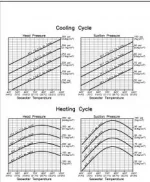Be careful with connections to you air conditioning refrigeration ports. There are two types of fittings. Plain threaded flared ports with no insert and schrader valves that have the valve insert in the center. The ports for the pressure sensors are probably true schrader valves meaning if you unscrew the sensor, the valve seals shut. Your backseat service valves are probably not schrader valves and if you move them from the back seat position with no gauges attached you will discharge refrigerant which can be dangerous especially on the high side during operation.
Liquid back to the compressor would "slug" it which makes a nasty knocking sound as a minimum and kills it worst case. Most of these units have reservoirs to prevent excess refrigerant from making it to the compressor so some overcharge is usually covered as are conditions on the extreme end of the scale. Conversely, inadequate refrigerant doesn't cool the compressor enough and failure due to excess heat may occur. That's the reason for the age old "cold can of beer" test where you should see some sweating at the suction service valve indicating some cold gas coming back from the evaporator coil. As the cabin approaches set point and especially if the humidity is low then this line will be colder because there is not much work for the evaporator to perform. At start up with a 90F cabin, this line can be at ambient for a while as the evaporator removes maximum heat and humidity.
So too much gas is bad, too little gas is bad and pressures/temps that don't make sense together are bad. The latter is how you find blockages, restrictions, air flow problems, etc even if the charge is perfect. It's frequently not the charge when things go wrong.
As far as your comment about the can sweating - frost anywhere on the suction line is bad, it should never be that cold. This can actually be low charge. Sweating on the can itself depends on how much and when in the cycle of heat removal. You want just enough gas coming back to cool the compressor but not enough more for it to be liquid. A better measurement is the compressor discharge temperature at the top of the can at the discharge port with an IR gun. You can compare units for starters.
As far as your comment about cooling water flow, it doesn't matter if the cooling water circuits are on the same pump or not, a given system can start having heat exchanger problems on its own. Part of routine maintainance is to flush the heat exchanger coils using high pressure pulsing city water pressure on each set of lines independently and all common lines. Never use acid unless absolutely necessary because this is the early demise of many a unit. I have two units that are 16 years old in an area with high marine growth and have never had to use acid on these coils to keep my high side pressures perfect.
I have an entire shop of AC gear but over the years I have found that the best first order measure of a systems health is to measure the delta T of the cabin vents. Get a baseline of the difference between the air going into the evaporator vs the discharge temp at the closest vent on a fully services unit near the set point. This should be 18-25F. When it starts to drop, something is up. I do this with my own systems around once a month with an IR gun. All temps and pressures should be measured once per year.
George


